COMMENT:
The pattern of sinusoidal infiltration may be seen with leukemic processes or may also be seen with other neoplasm. The appearance of the cells is suggestive of lymphoid or hematopoietic origin, at least on routine histology. The process does not appear to represent graft versus host disease. No evidence of Epstein-Barr virus is seen in this case.
Previous Biopsies on this Patient:
NONE
TPIS Related Resources:
Knodell Scoring
Liver Transplant Topics
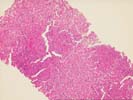
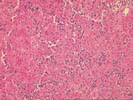
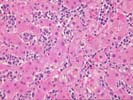
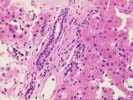
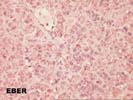
The specimen consists of a core of hepatic parenchyma with a diffuse sinusoidal infiltrate comprised of mononuclear cells. The cells have nuclei slightly smaller than those of hepatocytes. The nuclei are characterized by round to slightly irregular contours with inapparent nucleoli. The nuclei contain shallow invaginations and there is a small amount of amphophilic to eosinophilic cytoplasm. The cells do not appear to form glands or other recognizable structures. The cells appear separable from sinusoidal lining cells. The hepatocytes appear unperturbed by this process. No hepatocyte dysplasia is appreciated. Likewise, portal tracts are generally uninvolved by this process. An insitu hybridization for Epstein-Barr early RNA (Eber) is performed. The test is negative.